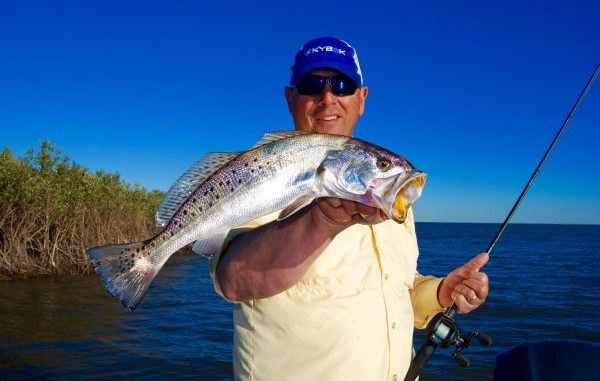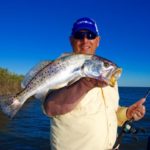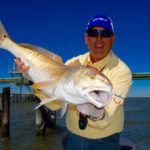
Mild winter means specks are already being caught on rigs in outside waters, Pellegrin said
Besides not having to wrap up your pipes, protect your plants or pull out your heavy coat, Louisiana’s mild winter so far this year brings with it an added bonus: speckled trout are already being caught in outside spots like Terrebonne Bay — in mid-February.
Capt. Tommy Pellegrin, with Custom Charters out of Houma, said warmer-than-usual temperatures this year allowed some specks to remain in outside waters all winter long — and he’s already catching them on soft plastics around several rigs in the area.
“The mild winter we had is allowing these fish to still be in the bay,” Pellegrin said. “If we would have had a really cold winter, these fish would have come into the deep holes in the marsh, or they would have gone offshore.”
On a trip Wednesday out of Trade Winds Marina in Cocodrie, we boated as many redfish as we wanted to handle, then pursued trout in the afternoon when the stronger-than-expected winds died down. In about an hour, 15 nice specks were in the box, and we probably should have had at least 10 more.
“It’s February, and the water temperature was 62 degrees,” Pellegrin said after returning to the launch. “It should be 50 or 55 degrees out there right now, but it just never got really cold. Last year, March 20 was the first day we caught numbers out in the bay, so we’re about a month early.”
Planning a trip when you’re confident of clear water and at least some tide movement is key, he said.
“If you don’t have clear water, you’re not catching them to start with because wintertime trout are sluggish. They’re sitting on the bottom waiting for it to be time to start feeding again. Now if something passes in front of them, they’re going to eat it,” he said. “So you fish it slow. You get an aggressive bite every now and then, but most of the time it’s what we saw.
“The numbers just aren’t there like they will be in the summertime, but the fish are going to be bigger.”
With soft plastics right now, Pellegrin prefers the 3-inch High Life Tackle Anchovy in natural minnow, coco pepper or purple-gold.
“There’s not many shrimp there yet,” he said. “The trout are eating mullet, cocahoe minnows and whatever they can find. So you’re hitting more with finfish right now, and the shrimp will get there in April.”
Don’t expect the trout to aggressively slam the lure. Many hits on Wednesday felt like the slightest of “ticks” on the line.
“You need a very smooth reel and a very sensitive rod because the bite is so subtle,” Pellegrin said. “I tell people, We’re fishing with a 3-inch bait. Think of a 2-inch fish trying to eat it. That’s how little of a pick you’re going to feel.’
“And when you feel that pick, you better be pulling because he’s going to let it go. It’s not like the summertime where they’re aggressively foraging. Why the bite is so light is they come up behind the bait and just inhale it. They’re not wanting to fight — they just grab it and swim with it going down.”
Pellegrin uses 30-pound Spiderwire braid with a 20-pound mono leader for trout. He said braid helps at detecting what some anglers describe as a “dishrag bite.”
“You don’t feel anything if you don’t have sensitive equipment, and then all of sudden you feel the heaviness of grass, or a dishrag, and you pull and you have a fish,” he said. “They don’t charge it and grab it and turn around and run. They just kind of suck it in and follow it down, so you really have to be able to feel that bite.”
What makes that task even more difficult is the presence of trash on the bottom. Pellegrin recommended a ¼-ounce jighead in 6 to 8 feet of water, then bumping up to a ⅜-ounce if you’re fishing deeper than that.
“I’m looking for any kind of structure on the bottom. Most of the rigs have some shell pads. A lot of the older pads are covered up with silt now, so you kind of have to study it and learn it,” he said. “A lot of times, the fish aren’t right next to the wellhead because a barge might have been on the shell pad, and the derrick cantilevered out and drilled the hole.
“Or the rubble from everything ended up out there, so it’s not real close all the time.”
He definitely recommended against throwing a double-rig until the fish become more aggressive later this spring.
“They just don’t work real well right now. You rarely get on a winter bite that would be doubles,” Pellegrin said. “Singles work better in this situation. You can control it better because you can feel that little subtle bite. You want to be able to feel that one bite and feel the lure working.”
For trout in outside waters, soft plastics will be your best option for at least another month to six weeks, he said.
“All of the marsh fish are going to be in their transitions back and forth. The reds, the drum and the sheepshead are all getting ready to spawn, so all this area is going to be full of fish,” he said. “If you want a trout, you’re going to almost have to fish plastics because the redfish, drum and sheepshead will eat up any shrimp.
“It’s just a great place to fish because the redfish are there on the really nasty days, and the trout are there on the better days.”




